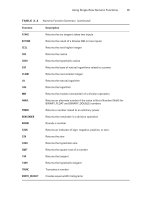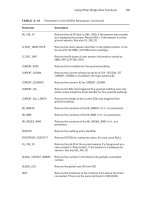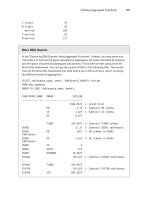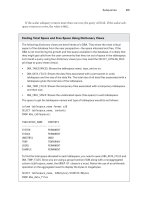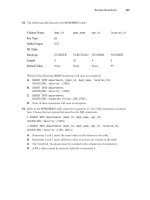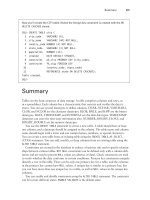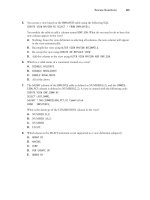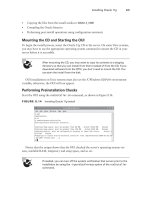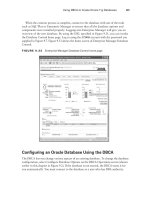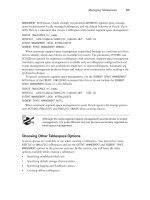Tài liệu Expert Oracle Database 11g Administration P2 ppt
Bạn đang xem bản rút gọn của tài liệu. Xem và tải ngay bản đầy đủ của tài liệu tại đây (144.22 KB, 10 trang )
xliv
■
INTRODUCTION
How to Become an Oracle DBA
As you start out on your journey to become a proficient Oracle DBA, you have many sources of infor-
mation on the Oracle database:
•Oracle Database 11g database administration classes, which have now been boiled down to a
pair of five-day long classes
• Oracle manuals—an entire library of which are available on the Oracle web sites
• Books from various publishers that impart the various pieces of knowledge you need to become
an accomplished Oracle DBA
You’ll also need to acquire the necessary operating system knowledge. Most of the large Oracle
databases are based on the UNIX (or Linux) operating system, so you’ll need to have a reasonably
good understanding of UNIX. Again, you have many sources of information available. You can attend
a class or two from the leading UNIX system vendors, such as Hewlett-Packard and Sun Microsystems,
you can read the manuals, or you can buy some books. Microsoft Windows is another popular oper-
ating system for Oracle databases, so you need to have a basic understanding of the Windows Server
operating system as well.
As many of the new entrants to the Oracle Database 11g field find out, the Oracle DBA world is
exhilarating, but alas, it’s also exhaustive in its reach and scope. It isn’t uncommon for DBAs to have
an entire shelf full of books, all explaining various facets of the DBA profession—modeling books,
UNIX texts, DBA handbooks, backup and recovery guides, performance-tuning manuals, and
networking and troubleshooting books. The amazing thing is, even after you run through the whole
gauntlet of courses and books, you aren’t really assured of being fully prepared to handle complex,
day-to-day database administration chores. There are many people who have taken all the requisite
classes to become an Oracle DBA who won’t or can’t be competent Oracle DBAs based solely on their
training. The reason? Refer back to that quotation from Shakespeare at the beginning of this intro-
duction: you need to separate the grain from the chaff, and all the coursework and manuals, while
excellent in their content, can serve to muddy the waters further.
The experienced Oracle DBA can find his or her way through this baffling amount of material,
but how’s the neophyte DBA to cope with the overwhelming amount of information? That’s where
this book comes in. This text will not only educate you in the theory and principles involved in
managing relational databases, it will also help you translate that theory into the useful, practical
knowledge that will enable you to manage real-life Oracle Database 11g databases with real-life data
and real-life issues.
Oracle Database 11g
The g in Oracle Database 11g stands for “grid.” The idea is to enable software to access spare processing
power across networks (grids) of inexpensive servers. Traditionally, database systems have been run
on large servers capable of running several very large databases at once. However, there are distinct
disadvantages inherent in the single-server model. For example, resources tied up in the large servers
can’t be redistributed among the various databases and other services to ensure an optimal alloca-
tion of resources. If you need a massive amount of resources to handle your database’s peak needs,
chances are that you’ll run with identical resources throughout the day, thus guaranteeing that you
are going to waste critical resources during low-utilization periods.
Grid computing provides a means of harnessing the power of a large number of cheaper servers
to supply the computing power you need in a flexible manner. This hardware would be servers like
the Intel-based blade servers, and the software would include the free (or almost free) open source
Linux operating system. By choosing small, generic servers, your system will cost much less than a
■
INTRODUCTION
xlv
traditional large server system, and because you can dynamically reallocate or provision resources
based on actual needs, you’ll be using resources efficiently.
Grid computing (also referred to as computing on demand and utility computing) isn’t a new
innovation invented solely by Oracle. The idea of grid computing has been around for a while, primarily
in the academic world. In fact, grid computing arose out of the academic community’s need for
extremely fast and scalable computers to perform complex, massive research tasks. Another over-
riding goal of the academic community was to permit the sharing of computing resources among
large numbers of researchers. Of course, the academics also aimed to keep the cost as low as possible.
Grid computing emerged out of these efforts as a viable way to create huge sharable computing envi-
ronments that are dynamically adjustable to changes in the demand for computing power.
When we talk about harnessing the power of a number of commodity servers, realize that the
number of computers may not be limited to just a handful. We are talking about combining the power of
a fairly large number of small servers linked together to form a grid. Obviously, the key idea here is
that the sum is far greater than the individual components. Enterprise grid computing, as envisioned
by Oracle, uses large pools of modular storage and commodity servers. Underutilization of resources
will be cut down, because capacity could be altered from the centralized pool of resources as necessary.
Here is a summary of the key benefits of grid computing:
• Flexibility: Since you are creating a single logical entity from a bunch of small servers, you can,
of course, add or remove individual components as your computing needs dictate.
• Efficiency: The concept of dynamic provisioning underlies grid computing. Dynamic provisioning
means that the allocation of resources for various services is not rigidly fixed, but changes
according to the need for resources and the availability of the resources. Ideally, a well-run
grid will channel resources to where they are needed the most by diverting them from under-
utilized sources.
• Easy manageability: It is far easier to manage a single logical combination of your computing
resources (which may include several databases and application servers), rather than monitoring
each one as a completely independent unit.
• Economy: The total cost of a grid environment could be considerably lower than a traditional
single, big server environment. Oracle strongly recommends the use of Linux-based commodity
servers, which Oracle says offer the best price/performance ratio.
Key Components of Oracle Database 11g
Following are the essential components of Oracle’s grid-based systems:
• Real Application Clusters (RAC)
• Information sharing
• Easy server manageability
• Extensive instrumentation
•The advisory framework
• Automatic performance tuning
• Automatic Storage Management (ASM)
• Automatic memory management
• Scheduling and resource management
• Real Application Testing
xlvi
■
INTRODUCTION
Note that you most certainly don’t have to use a “grid” platform to be able to use the Oracle
Database 11g server. In either case, you can take advantage of all the new features of the database system.
Real Application Clusters
Oracle has had a feature called the Oracle Parallel Server (OPS) for many years, which enabled people
to access the database from more than one instance, thus providing for scalability as well as high
availability. Oracle has refined the parallel server technology considerably over the years, eventually
renaming it Real Application Clusters (RAC) a few years ago.
■
Note
This book concerns itself exclusively with the “mainstream” Oracle Database 11g DBA concepts and tech-
niques. You’ll not find any discussion of the Oracle Real Application Clusters in this book. If you are interested in RAC,
you may want to take a look at Oracle manuals or refer to one of the many good books devoted to RAC.
Information Sharing
In order to efficiently share information over a grid spanning many heterogeneous systems, you
need to share information efficiently. Data exchange can be occasional (such as when you perform
data loads for a new system), or it could be regular and instantaneous (updating one part of the
system when something changes in another part). In order to facilitate either type of information
sharing, Oracle Database 11g provides transportable tablespaces and Oracle Streams.
Transportable Tablespaces
The transportable tablespaces feature enables high-speed transport of huge amounts of data from
one database to another, even if the databases are running on different operating systems. The ability
to move huge amounts of data across platforms, and even to rename the tablespaces during the process,
makes information exchange far easier.
Oracle Streams
Oracle Streams is a feature that enables you to effortlessly capture changes made in one database
and propagate them to subscriber nodes in the grid. The Oracle Streams feature can keep all the
copies in sync while the changes are being applied.
Easy Server Manageability
Through its Database Control and Grid Control interfaces, Oracle Enterprise Manager enables the
management of either a single database or all databases, application servers, hosts, listeners, HTTP
servers, and web applications as well.
The prevailing view among IT organizations is that Oracle is a complex, difficult-to-manage
database, especially when compared with the Windows server database, SQL Server. Oracle Database
11g makes a conscious effort to simplify management, right from the installation process through to
daily monitoring and performance tuning. There is a new common infrastructure for storing work-
load- and performance-related information. You can now use powerful SQL tuning tools to determine
ways to improve performance.
Oracle Enterprise Manager (OEM), which includes the single database-level Database Control,
and its enterprise-wide counterpart, the Grid Control, provide unsurpassed capabilities for managing
the database. Traditionally, Oracle DBAs relied on complex SQL scripts to monitor the database as
well as diagnose and fix performance problems. OEM now can help you do all those things and a lot
■
INTRODUCTION
xlvii
more, without having to spend enormous amounts of time writing lengthy scripts to help manage
the database.
■
Note
I’ve reduced the use of DBA scripts to the bare minimum in this book. Instead, I show you how to use the
OEM Database Control effectively to perform all your tasks quickly and with far less effort.
Extensive Instrumentation
Oracle Database 11g provides instrumentation of its code base that ranges further than any prior
release of Oracle, providing accurate metrics about database performance that weren’t available
until now. Oracle’s own instrumentation and metrics, since they are embedded in the database
code, provide better information without any measurable performance degradation, compared to
third-party performance-measurement tools.
The Advisory Framework
Oracle Database 11g contains several highly useful advisors to help you optimize the performance of
the various components of the database. Here are some of them:
•The Automatic Database Diagnostic Monitor (ADDM) helps you analyze current and past
instance performance.
•The SQL Tuning Advisor helps you tune SQL statements.
•The SQL Access Advisor tells you whether you should add (or drop) indexes and materialized
views.
•The Segment Advisor helps you figure out the necessary space for new tables and to reclaim
unused space assigned to segments, among other things.
•The Undo Advisor helps you configure the critical undo tablespace.
•The Memory Advisor provides recommendations for memory-related parameters.
Each of these advisors has a similar look and feel, and this consistency will help you learn how
to use them effectively. Using the advisors isn’t mandatory, of course—you can also tune space and
memory by using Oracle-supplied packages and various dynamic performance views—but it’s more
efficient to simply invoke the necessary advisor.
Automatic Performance Tuning
Oracle Database 11g provides you with automatic performance diagnosis and tuning recommendations.
An expert diagnosis tool called the Automatic Database Diagnostic Monitor uses the new Automatic
Workload Repository contents to analyze instance performance. The ADDM’s analysis includes a
summary of database problems ranked according to the amount of database time they’re costing, as
well as a list of recommendations to eliminate these problems. The ADDM’s recommendations may
include modifying configuration settings or running one of the advisors listed in the previous section.
Automatic Storage Management
A significant component of the Oracle’s push toward easier management is the Automatic Storage
Management feature. Traditionally, database administrators relied on third-party vendors, such as
VERITAS and EMC, to provide storage management tools for larger systems. ASM enables the auto-
matic management of disks without resorting to third-party Logical Volume Managers (LVMs).
xlviii
■
INTRODUCTION
You can use Oracle’s storage virtualization layer to automate and simplify the layout and
management of all Oracle database files, when you use ASM. Instead of directly managing numerous
files and disks, you can pay attention to a relatively small number of disk groups. If you need addi-
tional storage, you simply add new physical disks to the logical disk groups.
Automatic Memory Management
The Oracle Database 11g server provides you with an easy way of managing the memory needs of
your databases. Automatic memory management and automatic program global area management
use information collected from the instance to efficiently allocate both the major components of
Oracle’s memory allocation—the system global area (SGA) and the program global area (PGA).
Scheduling and Resource Management
It’s common for enterprise users to share computing resources, and there needs to be a way of
scheduling the users and sharing the enterprise’s resources efficiently. Oracle Database 11g DBAs
can use the Database Resource Manager to control and channel scarce database resources among the
various users of the grid. You can also use the Oracle Scheduler to manage and monitor jobs as well
as prioritize them.
Real Application Testing
Two major features of Oracle Database 11g—Database Replay and the SQL Performance Analyzer—
facilitate change management by letting you replay database activities and SQL workloads, respec-
tively. You can thus test the impact of a potential database or server upgrade, for example, by
invoking the Database Replay and the SQL Performance Analyzer tools.
Why Read This Book?
What sets this book apart from the others on the market is the constant focus on the practical side of
the DBA’s work life. What does a new DBA need to know to begin work? How much and what SQL
does the new DBA need to know? What UNIX, Linux, and Windows commands and utilities does the
new DBA need to know? How does a DBA perform the basic UNIX administration tasks? How does a
DBA install the Oracle software from scratch? How does the DBA use all the powerful new perfor-
mance tuning features of the Oracle Database 11g server?
This book provides the conceptual background and operational details for all the topics a
professional Oracle DBA needs to know. The following sections outline other reasons to choose this
book over its competitors.
Delivers a One-Volume Reference
This book’s specific purpose is to serve as a one-volume handbook for professional Oracle DBAs—as
a book that covers both the theory and practice of the DBA craft. As I mentioned before, most
newcomers to the field are intimidated and bewildered by the sheer amount of material they’re
confronted with and the great number of administrative commands they need to have at their finger-
tips. Well, everything you need to know to run your databases efficiently is right here in this one
book.
How did I manage to achieve the difficult feat of providing comprehensive instruction in just
one book? Well, although there is a lot of terrain to cover if you want to learn all the DBA material, you
